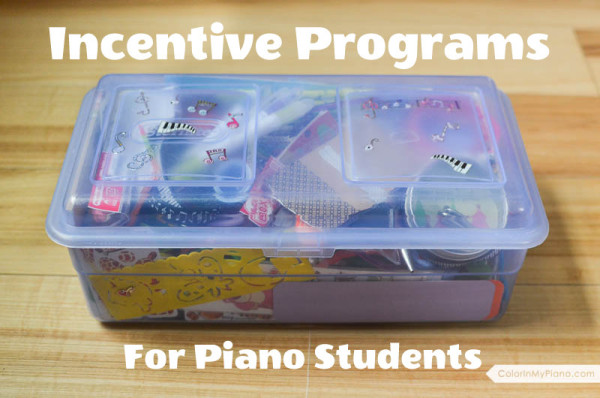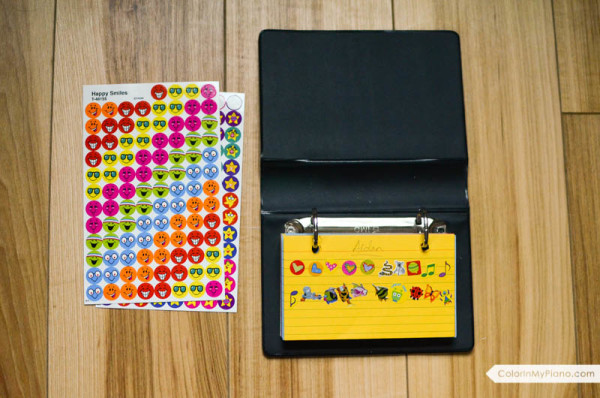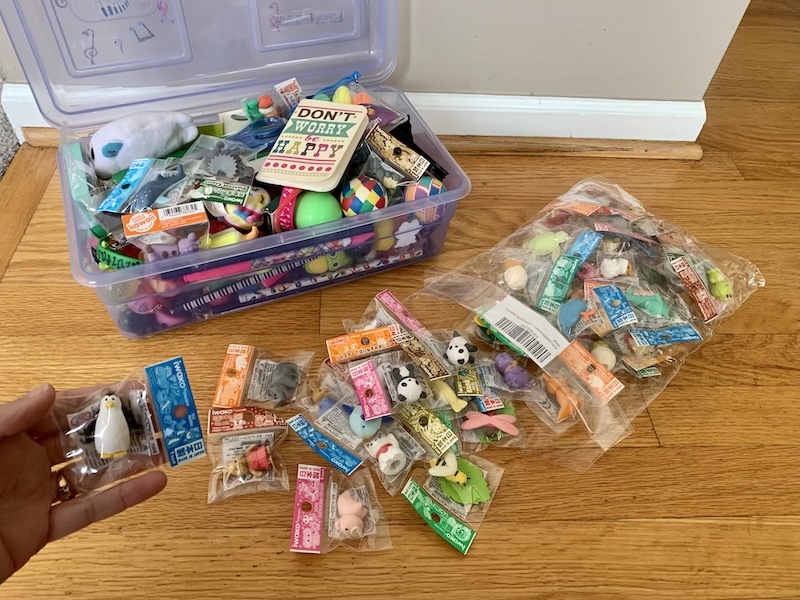
In the past, I’ve shared about my easy, ongoing incentive program for my piano students. You can read a more complete blog post from 2009 about it here.
Basically, the summary is that for every 30 pages of music students learn (or theory pages completed), a prize is earned from the prize box. My goal was to have a simple program that was easy to track and that rewarded the kinds of things my students should be doing anyway. A simple incentive program can make things fun and help reinforce the kinds of things you wish students to be focused on. My students know that a given piece needs to reach a certain level of mastery before they can “pass” it and go on to the next.
I have maintained this simple incentive program consistently for years (although, I’ll admit I’ve taken a little time off from it recently due to pandemic online teaching and relocating to Michigan). However, I recently came up with a slight improvement to this method that I think will make it EVEN EASIER to maintain.
Previously, I would track of the number of pages students mastered using stickers on an index card, like this:

This worked well, but my new idea is to award students a prize whenever they reach the halfway point through their book (the point where you can see the staples!) and again at the end of the book. No more worrying about tracking how many pages students have completed!
Now, you might be thinking: what about spiral bound books? And what about pieces that are individually printed solos? My plan is that students and I can do the math with the page numbers to find the halfway point in any spiral bound books. Individually printed solos don’t need to count for anything in the incentive program, unless it’s a special, lengthy piece where they’ve really worked hard.
This is a flexible incentive program. As students become more advanced, many students tend to become less interested in prizes and the incentive program tends to naturally phase out. Other students remain interested for a long time. I can allow students to choose from the prize box at any point it seems logical to celebrate: such as completing an RCM exam, participating in a local ribbon festival or special recital, etc.
I just restocked my prize box with more Iwako Japanese puzzle erasers I ordered from Amazon (see the package I ordered here). These puzzle erasers are always a hit with students! They are also great as game pieces on or away from the keyboard.

(Please note that this post contains Amazon affiliate links to support my blog. To check out more of my Amazon favs, visit amazon.com/shop/joymorinpiano. Thanks for your support!)
I keep lots of other fun things in my prize box, too, besides the Japanese puzzle erasers. When out shopping, I always keep an eye out for fun pencils, highlighters, small notepads, bouncy balls, plastic bracelets, keychains, etc. (See here or here for more photos of prize box items.)
Anyway, I just thought I’d share about my small tweak I made to my incentive program! It’s nothing big, but having this simple incentive program in place helps my students learn to have the same priorities as me: progress and expressive music making.
Your turn: I would love to hear from you! What kind of incentive program have you found to work for your studio? Please leave a comment.


It’s always been when they completed their book! 🙂
That’s great — simple, and easy! 🙂
I’ve never given prizes for longer-timed accomplishments, but I think I like the idea. For the Japanese erasers do you give a whole package or just one or two. The picture you show above has packaged “doodads”. Are these also on Amazon? Currently I offer a candy at the end of each lesson. I also “bribe” the student with candy if they excel at something special during the lesson, even if it’s just “can you play that three times in a row CORRECTLY” .
For the Japanese puzzle erasers (that’s what those small packaged animals are), I allow students to choose just one. And yes, I bought them on Amazon here: https://amzn.to/3tDdTrf. When you buy a bulk package like I did, the erasers come out to about $0.60 apiece!
Thanks for sharing examples of how you use “bribes” in your lessons. Sounds like fun! 😉
I did something in the past where my students would earn stickers for different things: a sticker for playing for somebody outside of the family they live with, a sticker for memorizing a piece, a sticker for playing for a recital or for church, and a sticker for when I felt like they needed another sticker. When they got to seven stickers, they would get something from prize box. But it became hard to find prizes. So I decided to get the parents involved. When they would get to seven stickers, the parents could get them a prize or give them a dollar or whatever they decided. This is what my piano teacher did for my sister and I. But I like getting things for my students, so sometimes I’ll get them little things here and there and praise them for their hard work. I love finding new ideas and am open for advice. I’ve been teaching piano for 3 years now, so I’m still learning??
Those are great things to ask students to do! And I really like the idea of getting parents involved doing something special for the students! This would be a good solution also for online lessons, when I can’t as easily let students choose from my prize box. 🙂
Currently I use Andrea Dow’s practice punch cards–one for each student each week. Each week that a student practices 5 or more times (AND records it on the punch card) their card joins the cards in my 5+ bowl. At the end of every month I draw one completed punch card from the bowl and give that student a $15 gift card to Amazon.
My students find that very motivating and it ends up costing less each month than the other little prizes I had been buying for my prize box!
I do switch incentive programs every 6-12 months, though. I guess maybe I get bored? Haha!
Ooo, that sounds like a very fun ongoing incentive program, Audrey! Thanks for sharing this idea!
Hello Joy! I too use incentives. My younger students age 6-12 love the concept. I use event tickets. I tape a zip lock bag in the back of the students agenda/dictation book. They need to collect 4 tickets in order to pick from the “loot drawer”. I have a 5 drawer gracious living system. It is small, but big enough to hold pencils, erasers, highlighters, sticky notes, book marks, magnets, small chocolate bars and hard candy. Once the student collects four tickets from completing each weeks worth of homework successfully, they roll the dice. If they roll a 6 they get to pick out two items. When they roll a 1-5, they pick out of the corresponding drawer. If they don’t want to cash in their 4 tickets, they can save them up (12) for a larger prize, hot wheel cars, lego, yoyo’s, necklaces, earrings. (I make jewellery on the side as a hobby). I am always open to new ideas. Students love surprises and being rewarded for a job well done. Thanks for sharing your idea and for the ideas written above.
This sounds so fun, Cyndi! I can see how rolling of the die adds a fun element of chance and surprise. Thanks so much for sharing!
I love this. I usually put a sticker on each page when it’s complete but I love the idea of having to be patient and work towards the prize.
I have a somewhat related question. What do you do when a student just isn’t practicing and mastering the piece? I hate having them do the same page week after week after week but I can’t let them go on if they haven’t mastered it.
You can still put stickers on each page, too! I’ve always enjoyed letting students to that. 🙂
What to do when a student seems stuck on a piece… First, I try to figure out why the piece isn’t getting practiced. Does the student not like the piece? Or are they overwhelmed or unsure about how to practice it? Sometimes, we’ll do a lot of in-lesson practicing together to help solve whatever issues are yet to be resolved. Sometimes, if the student just doesn’t care for the piece that much, I won’t worry about getting it completely perfected. (As long as this doesn’t become a trend.) There’s so much great music out there, and life is too short to play music we don’t enjoy. 🙂
I give a prize after every 10 pieces. Most of my students are at the elementary level and it might take 2 – 3 weeks to finish one piece. Obviously, this dorsn’t work for intermediate students, but usually by the time my students reach that level they don’t really want/need prizes. My students really look forward to earning a prize! If I don’t tell them how many they have already learned, they ask “What number am I on?” or “How many until my next prize?” In my prize bag I have things from Amazon, the Target dollar bins, the dollar stores, and even toys from TJMAXX when they go on mega clearance. Last year I bought some heavily discounted children’s masks with a “Frozen” theme and even these have been popular, recently! The little ones say “I love Elsa!” and the bigger kids say “I could use this for school!” It’s been a good motivator in my studio!
Sounds like you have a great system, Amy! Thanks for sharing! And thanks for the tips about where to find prizes and that masks are a bit with your students.
I do something similar, may have gotten the idea from you years ago. I do a spiral bound notecard system. One page has their practice and one for pages passed off. One star = one hour of practice. When they reach 10 stars, they get a prize usually candy bar or pack of candy. (I teach mostly middle school.) When they pass off 20 pages of music, they can receive a prize. The 20 pages works well for any book or longer piece for any age. 2 page song = 2 stars. 5 page song = 5 stars. This seems to be fair. Two ways to earn a prize! But most of my older students phase out as they don’t need an incentive because they have matured and learned to enjoy the process! I enjoyed reading the comments from other teachers!
Thanks for sharing about your incentive program, Donna! It does sound similar. But I like your idea to allow two ways to earn a prize!
I’ve been trying to work out an incentive program, so this is great! I’m worried that if II give incentives to often, the music itself won’t mean as much. Did you have to change your length of goals when you first started?
I think your concern is valid — we don’t want external motivators to squelch internal motivators. We want the music to mean something to students. I try to make sure my incentive program is simple and fun — something not a big deal, but that adds and supports the musical experience the students get.
You ask whether I had to change my length of goals when I first started. Do you mean the number of pages mastered? Initially when I started the incentive program, I think I chose 25 pages as the amount for earning a prize. I did tweak that to 30, but mostly just because of a practical reason. 30 allowed me to put three rows of 10 stickers on an index card. Visually, it was easier for me to keep count by 10s. 🙂 And of course, as I described in the blog post above, now I am opting to allow a prize at the halfway and end of a book finished. Those are really the only tweaks I’ve made since I began this incentive program years ago for my students.
I love this idea! I’ve always given my students stickers at the end of their lesson but I really like this idea for giving a little prize for completing a book.
Glad you like the idea, Alejandra!